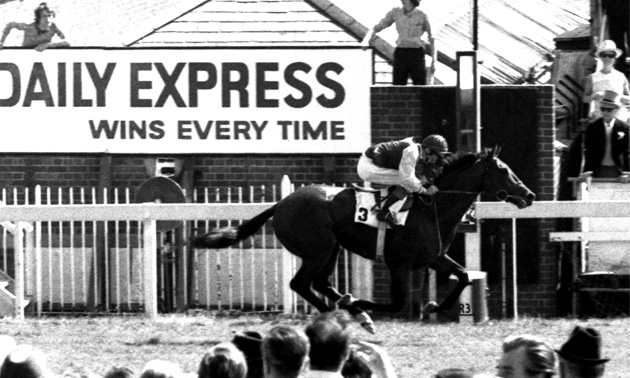In any discussions of greatness, many of which understandably involve Timeform ratings, versatility has a habit of being sold short. It is something to be very good in terms of raw ability, but it is something else to be very good at a wide range of distances and/or on different goings and track types.
That is what is supposed to be tested by the British horseracing triple crown, made up of the 2000 Guineas at Newmarket at eight furlongs early in a three-year-old’s season, followed by The Derby at Epsom at twelve furlongs just a month further on, and, finally, the St Leger at Doncaster at an extended fourteen furlongs more than three months later (though dates and distances have sometimes moved around).
There were several triple crown winners in the century-and-a-bit after the Guineas, and therefore the triple crown, was instituted in 1809, starting with West Australian in 1853 and including the legendary pair Gladiateur – “The Avenger of Waterloo” – in 1865 and Ormonde in 1886.
But there has been just one since Bahram in 1935, and the fact is that not many horses are asked to try any longer.
That is not just down to a lack of Corinthian spirit in the sport. As racing has got more competitive – and, frankly, better – down the years, specialisation has increased along with the allure of alternative targets.
To just what degree specialisation rules over versatility these days may be gauged by a look at the usual range of winning distances for three-year-olds in Britain in the modern era (or, more specifically, in 2019).
The following shows the frequency of wins by distance range, in terms of furlongs, so a horse with a range of, say, 4 had a maximum winning distance as a three-year-old that was four furlongs further than its minimum winning distance in the same year.
Most three-year-olds fail to win a race, and, of the remainder, the majority win at only one distance (judged by the furlong at the front of the race-distance description). To win the Guineas and the St Leger requires a distance range of 6. A vanishingly small number of three-year-olds manage that.
Nijinsky managed that. It was he who won that most recent triple crown, in 1970, and it is so long ago that even I cannot remember its happening!
Fortunately, Timeform had been going for more than 20 years by then, and its Racehorses annuals were firmly established as the record of choice of the great and the ordinary alike.
Racehorses of 1970 told it thus: “…Nijinsky made the racing year: such were his feats that he dominated it from start to finish”. It also recorded the doubts at the time (after the Guineas) about whether Nijinsky would stay a mile and a half, never mind even further, and referenced the fast ground and small field at Epsom as factors in his favour that day.
Modern form analysis enables us to go further in assessing the whys and wherefores of Nijinsky’s year. For instance, it tells us that Nijinsky was by no means typical in how he strode. Most horses have a way of striding, in terms of their leg speed (or “cadence”), and more or less stick to it throughout their careers.
Nijinsky’s cadence late on in the Guineas, which he won most impressively from Yellow God and Roi Soleil, and the Derby, in which he beat Gyr and Stintino, was significantly higher than in the St Leger.
At Newmarket, he was mostly in the 2.30 strides/second to 2.41 strides/second area, typical (we now know) of a mile to mile-and-a-quarter performer. At Epsom, he was slightly higher, at 2.40 to 2.45 (as far as can be told from the grainy footage). At Doncaster, he dropped as low as 2.19 strides/second – the sign of a middle-distance/stayer if maintained – and went as high as 2.38, although only briefly.
Somehow – and it is reasonable to imagine this may have something to do with his genius trainer Vincent O’Brien and his genius jockey Lester Piggott – Nijinsky was high-rev enough when needed and low-rev enough when needed, also.
Sectionals in the Derby also tell us something about how Nijinsky was so special, not just among his contemporaries, but across the generations, too, for he ran the last two furlongs at Epsom in approximately 10.60s then 11.25s for a final quarter of 21.85s that may never have been bettered (Derby videos before the 1980s are hard to come by).
Galileo – 22.65s in 2001 – Sea The Stars – 22.60s in 2009 – and Golden Horn – 22.40s in 2015 – have been the fastest from 1979 onwards, by the way.
Firm ground, and what we may infer to have been a steady early pace (finishing speed of 117.7% is well above par, even over the Derby course at Epsom), played to Nijinsky’s strengths against a rival in Gyr who went on to win the Grand Prix de Saint-Cloud and be rated 131 at season’s end. Nijinsky ended up on 138.
And so to the St Leger for Nijinsky, via the Irish Derby and the King George VI and Queen Elizabeth Stakes, both of which he won superbly. Footage at Doncaster shows Piggott easing Nijinsky into contention and then nursing him home under hands and heels.
In Meadowville (who was closing at the line and beaten just a length), Politico and Charlton, he beat horses ultimately rated 125, 124 and 119: no mugs, then, but no Nijinskys, either. Nijinsky’s class and adaptability got him home in front for a famous success without his having to run near his best.
#ThrowbackThursday
— Doncaster Racecourse (@DoncasterRaces) February 15, 2018
The mighty NIJINSKY became the first horse for thirty-five years to win the English Triple Crown which included the Derby, 2,000 Guineas & of course the St Leger Stakes in 1970
Here's Lester Piggott accompanying him to victory in the #StLeger 48 years ago... pic.twitter.com/plKoerlQE7
Regrettably, that proved to be the last win, but not the last race, for Nijinsky, who was reported to have lost 29 lb after Doncaster (many things have changed for the better, but we still do not know horses’ race-day body weights). He came up just short in the Prix de l’Arc de Triomphe at Longchamp and a bit more than short in the Champion Stakes at Newmarket.
It is a very tough job to show the versatility Nijinsky showed in winning the triple crown in 1970, it is tougher still to do so while maintaining form through a long and busy year.
There have been few horses who could get near what Nijinsky managed in the 50 years since. You first must win the Guineas and the Derby, of course, to be eligible for the final leg.
Nashwan ticked the first two boxes in 1989 but was then kept to a mile and a quarter and a mile and a half. Reference Point ticked the last two boxes in 1987 but had been sidelined at the time of the Guineas and might well not have been quick enough for a mile at three anyway.
The nearest miss came in 2012, when Camelot won a soft-ground and substandard Guineas, the Derby in good style, and turned up at Doncaster for the St Leger at 2/5, only to be beaten by the longshot Encke (who missed the following year after testing positive for a banned substance and failed to win again). It’s a funny old game at times.
However, the triple crown winner that really got away was arguably Sea The Stars in 2009. A comfortable winner of the Guineas and a somewhat messy Derby, he was getting better and better by the autumn but bagged the Irish Champion and the Arc while leaving Doncaster alone.
Sea The Stars had plenty of pace, as well as prodigious ability, but it is difficult to believe he would have done anything other than win the St Leger. It went instead to Mastery, rated 122 in Racehorses of 2009 compared to Sea The Stars’ 140. A 73-y-o Lester Piggott could have come out of retirement and still won on him, probably!
The Guineas winner Kameko’s non-staying fourth at Epsom means there will be no triple crown winner again this year, 50 years on from Nijinsky, and it could be a very long wait for the next one.
There have been horses who have won the St Leger through class more than stamina – Nijinsky was one – but usually a fair measure of both is required. In this year’s field we have the Derby winner Serpentine (by no means a certain runner), a Great Voltigeur winner in Pyledriver, an Irish Derby winner in Santiago, and a wide-margin March Stakes winner in Subjectivist, to name just a few.
We also have, in Hukum, a colt who has improved by about a stone on Timeform performance ratings with each start, winning a minor race at Kempton at two, the King George V Handicap at Royal Ascot on his return, and the all-aged Geoffrey Freer Stakes at Newbury last time.
Hukum is a son of the aforementioned Sea The Stars and seems likely to stay the extra furlong and a bit on top of the Newbury distance, which is what is being asked of him at Doncaster. If he can find another stone of improvement on the form of his latest run then we will have an exceptional St Leger winner to make up for another year without a triple crown one.






















.jpg)


 Url copied to clipboard.
Url copied to clipboard.




.jpg&w=300)






























